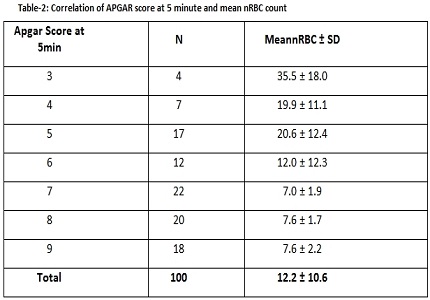Study of nucleated RBC count as a marker of severity of perinatal asphyxia in newborns - a case control study
Abstract
Introduction: This study was done to estimate the nucleated red blood cell count (NRBCs) in normal and asphyxiated babies and find their correlation with severity of birth asphyxia.
Materials and Methods: About 50 normal newborns as control and 50 newborns with perinatal asphyxia as cases were considered. At birth 2 mL of venous blood was collected in both cases and control groups. nRBC count per 100 white blood cells (WBC) was done at admission. Clinical assessments in terms of neurologic status at birth, 24 hours after birth and every day thereafter till discharge/death was done. Cord blood nRBC/100 WBC was correlated with stages of HIE during hospital stay. Neonates were monitored for adverse outcome such as tone abnormalities, feeding difficulty, refractory seizures and death. Controls were followed up in the same manner.
Results: Among 50 cases, 24 had no hypoxic ischaemic encephalopathy (HIE),17 had stage 1 HIE, 6 had stage 2 and 3 newborns had stage 3 HIE. The mean APGAR score in cases was 5.34 ± 1.19 where as for the control group it was 8.12 ± 0.77 with p value of 0.001 which is statistically significant. The mean nRBC in newborns with APGAR score of 3, 4,5, 6 were 35.5, 19.9, 20.6 and 12 respectively. The low APGAR scores showed high nRBCs. Mean nRBCs for HIE stage 1, 2, 3 was 19.1, 31.0, and 54.3 respectively. High nRBC count correlated with increasing severity of birth asphyxia.
Conclusion: nRBC count is an easy, simple and a reliable test to assess the severity of birth asphyxia in resource poor settings.
Downloads
References
2. World Health Organization. Neonatal and Perinatal Mortality; Country, Regional and Global estimates, 2004; WHO, Geneva. 2006; 1-25.
3. National Neonatal and Perinatal Database Report.2002-2003;1-58.
4. Colacoa SM, Ahmed M, Kshirsagar VY, Bajpai R. Study of nucleated red blood cell counts in asphyxiated newborns and the fetal outcome. Int J Clin Pediatr. 2014;3(3):79-85. doi: http://dx.doi.org/10.14740/ijcp169w.
5. IAP-NNF Guidelines on neonatal resuscitation; 2006; 137-140.
6. Sarnat HB, Sarnat MS. Neonatal Encephalopathy Following Fetal Distress. A Clinical and Electroencephalographic Study. Arch Neurol.1976; 33(10):696-705.
7. Ghosh B, Mittal S, Kumar S, Dadhwal V. Prediction of perinatal asphyxia with nucleated red blood cells in cord blood of newborns. Int J GynaecolObstet. 2003 Jun; 81(3):267-71. [PubMed]
8. Maier RF, Bohme K, Dudenhausen JW. Cord blood erythropoietin in relation to different markers of fetalhypoxia. Obstet Gynecol. 1993:81:575-580.
9. Ganta SJ, Kulkarni SR, Renuka DB. Study of cord blood nucleated RBC’s as a marker for fetal asphyxia. Int J Reprod Contracept Obstet Gynecol 2017;6:658-62..DOI: http://dx.doi.org/10.18203/23201770.ijrcog20170402.
10. Rai R, Tripathi G, Singh DK. Nucleated RBC Count as Predictor of Neurological Outcome in Perinatal Asphyxia. Indian Pediatrics. March 2014; 51. [PubMed]
11. Mohanty AK, Das L, Pradhan S, Meher B, Beriha SS. Cord Blood Nucleated RBC as a Predictor of Perinatal Asphyxia, Severity and Outcome. Ind J Clin Pra. 2014; 24(10).
12. Kil TH, Han JY, Kim JB, Ko GO, Lee YH, Kim KY et al. A Study on the measurement of the nucleated red blood cell (nRBC) count based on birth weight and its correlation with perinatal prognosis in infants with very low birth weights. Korean J Pediatr 2011; 54(2): 69-78 . DOI: 10.3345/kjp.2011.54.2.69.
13. Boskabadi H, Maamouri G, Sadeghain MH, Ghayour-Mobarhan M, Heidarzade M, Shakeri MT, et al. Early diagnosis of perinatal asphyxia by nucleated red blood cell count: a case-control study. Arch Iran Med. 2010;13(4):275-81. [PubMed]
14. Hanlon-Lundberg KM, Kirby RS. Nucleated red blood cells as a marker of acidemia in term neonates. Am J Obstet Gynecol. 1999;181:196-201. [PubMed]
15. Meena P et al. Correlation of nucleated red blood cells with severity of birth asphyxia and its immediate outcome in term newborns. Int J ContempPediatr. 2016 Aug;3(3):841-846.DOI: http://dx.doi.org/10.18203/2349-3291.ijcp20161430.
16. Hermansen MC. Nucleated red blood cells in the fetus and newborn. Arch Dis Child Fetal and Neonatal Ed. 2001;84(3)F211-5.
17. Mamta Malik, Ritu Mital, Vijay Jaiswal, Nisha P. Malik, Vikas Agarwal, Amit Upadhyay. Correlation of ac-idosis with blood markers (LDH and nucleated RBCs/100 WBC) and with mortality and neurodevelopmental outcome in neonates with perinatal asphyxia. International Journal of Contemporary Medical Research 2016;3(4):938-942.

Copyright (c) 2018 Author (s). Published by Siddharth Health Research and Social Welfare Society

This work is licensed under a Creative Commons Attribution 4.0 International License.


 OAI - Open Archives Initiative
OAI - Open Archives Initiative


